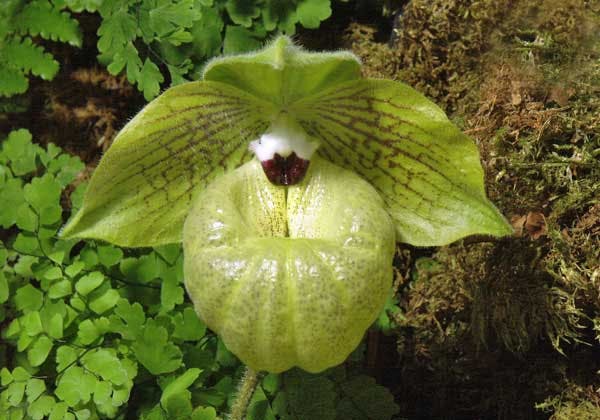
Striking green flower, large checkered leaves, spotted purple underneath, tall impressive flower stem and raspberry fragrance; Paphiopedilum malipoense has it all! This recently discovered species wasn't described until 1984 and it's hard to imagine how this incredible plant remained unknown for so long. While the best clones of this species exhibit strong, uniform, green color and the petals are overlaid with clear, crisp maroon tessellation, the depth of both background color and tessellation can vary dramatically in intensity.
The species, currently extremely threatened, is known only from the eroded limestone outcroppings (karst) of southwest Guanxi, southwest Guizhou, and southeast Yunnan provinces of China and similar habitats across the border in northern Vietnam. In Guizhou province it has been found growing with other cool-growing orchids such as Paphiopedilum concolor, Vanilla annamensis, Phalaenopsis wilsonii, Vanda concolor and Cheirostylis sinensis. As evidence of its rarity, collected plants have sold in the Kunming Flower Market for between 30 and 50 yuan (about $4.40 to $7.30) while Paphiopedilum micranthum sells for around 10 yuan ($1.46) per kilo (2.2 pounds)!
While a very adaptable species in cultivation, the key to best flowering is a rather cool winter rest. In its native habitat, summer days average 80° F or higher and humidity and rainfall are very high. This is followed by a sharply cooler and drier winter with days averaging about 60° F (15° C). Nights can easily drop to 32° F (O° C) or even a degree or two below freezing. Winters in this part of the world are typically very dry and often the only moisture available to the plants is in the form of nightly mists that form on the hills and forests.
In cultivation, plants can be easily grown in pots of any good semi-terrestrial potting mix suitable for other paphiopedilums although extra care should be given to adequate drainage. While these plants are found growing on only limestone, this more likely has to do with available mycorrhizal fungi necessary for seed germination than supplying calcium to the growing plants and its addition to the potting mix is probably not really necessary. Limestone is soluble in cold water and plentiful moisture is available only during the hot summer months. If you do add calcium to your potting mix be aware that, depending on the form you chose, significant increase in potting mix pH can occur. During the spring and summer growing season, the plants should be kept quite warm, shady, humid and not allowed to dry out completely between watering. During the winter months, the plants should be kept on the cool side and much drier; allowing the plants to dry completely between watering much like a succulent. Like all paphiopedilums, these plants require light feeding. Choose a good, complete fertilizer and apply at no more than ¼ the recommended rate.
Oh, and a word about patience. This species takes an excruciatingly long time to develop its inflorescence and for the flower to open. In some cases, it can be months between the time the developing inflorescence is visible in the center of the mature growth to the point the flower opens but the wait is well worth it. Be careful increasing temperatures to speed up the process. You might just be rewarded with bud-drop!
Ron McHatton, March 2009









